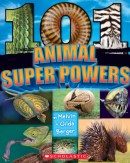
Supercharge your Story
How do animals supercharge their bodies? Stupendous survival strategies you call adaptations! How do you supercharge your writing? Stupendous strategies you can snag from this month’s books! High energy text can be extremely effective. Sometimes that energy just spills out as you write, but sometimes it is tougher to come by. Fortunately, a few fine-tuning exercises may be all you need to take your writing from fizzle to sizzle!
Vivid Verbs

Sure your characters could just eat something, but take a clue from Kate Messner and have them smash, zap, sting or devour. Right in her title, Insect Superpowers: 18 Real Bugs that Smash, Zap, Sting, and Devour, strong verbs show readers that the pages to come won’t be bland.
Put It in Practice:
- Identify a passage of text that is less than energetic.
- Highlight every verb.
- Replace at least half of those with stronger verbs. How?
- Think active. Play a movie of the action in your mind. Now run it again in slow motion or under magnification. What motion happens? What causes the action? What results from the action?
- Think auditory. Hear the sounds that might accompany it. Would any of those work to convey the action?
- Think analogy. If no action happens, come up with an analogy. “A tree has leaves” becomes “A tree holds leaves.”
- If all else fails: beg, borrow, or bend an idea until it works. Flip open Insect Superpowers: 18 Real Bugs that Smash, Zap, Hypnotize, Sting, and Devour. Make a list of supercharged verbs from the page and work them into the text you are working with. Yes, this may require creative revision, but that’s what writers do!
Snappy Sounds
Strategic use of sound can make writing sing. Although excessive use of alliteration (repeated initial consonant sounds), assonance (repeated vowel sounds) or other devices can feel forced, the right balance will help the words ring true.
In the following text, note level of energy: “Tiger beetles are the fastest insects. They can go five miles an hour when pursuing food or mates. That is fast for a small beetle.” It includes facts and conveys the concept, but it sounds stagnant when compared to these lines from Insect Superpowers:
“The tiger beetle is the fastest of all insects. Some can run more than five miles per hour to chase after prey and potential mates. That might not seem superfast, but when you consider the tiger beetle’s size, it’s pretty impressive.”
Which words made the difference? Which sounds were successful?

Alliteration is fairly easy to notice, but don’t let the power of assonance slip by. In Eels (Superpower Field Guide) Rachel Poliquin takes advantage of strong verbs and assonance to turn a definition into something more delightful: “Olenka is a nocturnal predator, which means she lazes her days away, curled up in her burrow at the bottom of the muddy river.” What other devices can you spot in there?
Put It in Practice:
- Find a piece of text that includes strategic use of sound. Page 7 of Melvin and Gilda Berger’s 101 Animal Superpowers would work.
- Highlight as many sound examples as you can. Make note of the location (within the sentence and within the passage) of the examples. Can you draw any conclusions from that?
- Re-write the passage eliminating the use of that device to see how that changes the reading experience.
- Re-write it, adding additional alliteration and assonance and note any differences it makes.
- Revise until you find a balance you like. Then, consider what variables affected your choice (pacing, content needing emphasis, availability of words,…).
Max Impact
Rachel Poliquin maximizes the impact of each example. “Slimetastic Safety Shield,” “Supersecret Lair of the Abyss,” Globe-Spanning Grit”? Sure those use strong words and put sound to work, but they go further. She stretches to the edges of what we call “nonfiction”—and we all know that young readers love to push the boundaries! Her language connotes that the topic is fun, the writing is playful, the reading will be joyful.
Here’s another example. In an author’s note at the beginning of Animal Zombies!: And other Bloodsucking Beasts, Creepy Creatures, and Real-Life Monsters, Chana Stiefel challenges readers with a dare. She labels readers as brave, she teases them with brain invasions, she hits home with monsters under their mattress. There’s not much more extreme than a zombie…
Put it in Practice:
- Generate a list of “extreme” words or phrases.
- Snatch words to add to your list by watching ads, reading headlines, surfing social media, analyzing clickbait, listening to kids chatting excitedly…
- Organize your list by mood/tone/energy.
- Use your list to push a piece of text toward a specific emotional energy.
When we read energetic writing it may seem like the writing process was simple, as if the words flowed out, but developing skills require training and finesse requires constant fine tuning. So . . . crush it! Every writing workout you complete builds your skills. Now is the time—grab a bunch of books, train your brain, and rev up your writing!

Heather L. Montgomery writes for kids who are wild about animals. An award-winning author and educator, Heather uses yuck appeal to engage young minds. Her books include: Something Rotten: A Fresh Look at Roadkill, Who Gives a Poop? Surprising Science from One End to the Other, and What’s in Your Pocket? Collecting Nature’s Treasures. Learn more at www.HeatherLMontgomery.com












